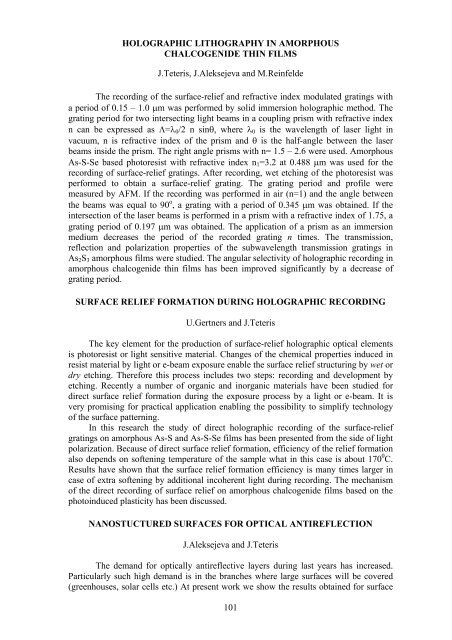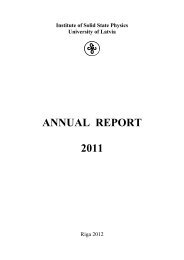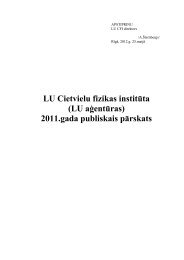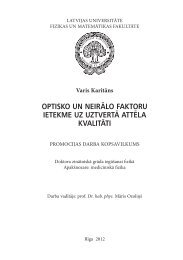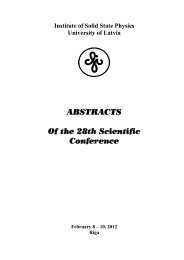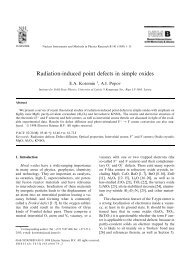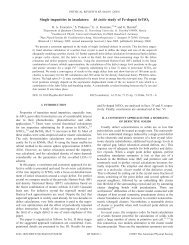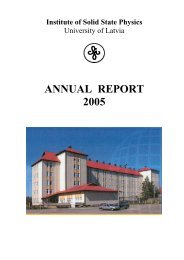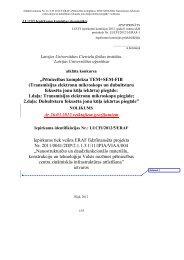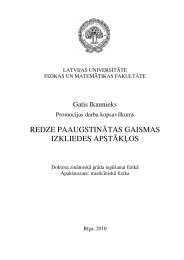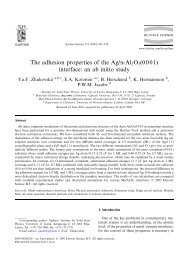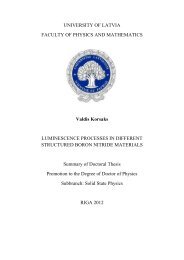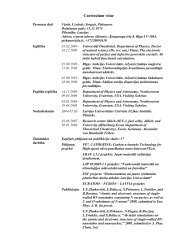Annual Report 2012 - Latvijas Universitātes Cietvielu fizikas institūts
Annual Report 2012 - Latvijas Universitātes Cietvielu fizikas institūts
Annual Report 2012 - Latvijas Universitātes Cietvielu fizikas institūts
Create successful ePaper yourself
Turn your PDF publications into a flip-book with our unique Google optimized e-Paper software.
HOLOGRAPHIC LITHOGRAPHY IN AMORPHOUS<br />
CHALCOGENIDE THIN FILMS<br />
J.Teteris, J.Aleksejeva and M.Reinfelde<br />
The recording of the surface-relief and refractive index modulated gratings with<br />
a period of 0.15 – 1.0 μm was performed by solid immersion holographic method. The<br />
grating period for two intersecting light beams in a coupling prism with refractive index<br />
n can be expressed as Λ=λ 0 /2 n sinθ, where λ 0 is the wavelength of laser light in<br />
vacuum, n is refractive index of the prism and θ is the half-angle between the laser<br />
beams inside the prism. The right angle prisms with n= 1.5 – 2.6 were used. Amorphous<br />
As-S-Se based photoresist with refractive index n 1 =3.2 at 0.488 μm was used for the<br />
recording of surface-relief gratings. After recording, wet etching of the photoresist was<br />
performed to obtain a surface-relief grating. The grating period and profile were<br />
measured by AFM. If the recording was performed in air (n=1) and the angle between<br />
the beams was equal to 90 o , a grating with a period of 0.345 μm was obtained. If the<br />
intersection of the laser beams is performed in a prism with a refractive index of 1.75, a<br />
grating period of 0.197 μm was obtained. The application of a prism as an immersion<br />
medium decreases the period of the recorded grating n times. The transmission,<br />
reflection and polarization properties of the subwavelength transmission gratings in<br />
As 2 S 3 amorphous films were studied. The angular selectivity of holographic recording in<br />
amorphous chalcogenide thin films has been improved significantly by a decrease of<br />
grating period.<br />
SURFACE RELIEF FORMATION DURING HOLOGRAPHIC RECORDING<br />
U.Gertners and J.Teteris<br />
The key element for the production of surface-relief holographic optical elements<br />
is photoresist or light sensitive material. Changes of the chemical properties induced in<br />
resist material by light or e-beam exposure enable the surface relief structuring by wet or<br />
dry etching. Therefore this process includes two steps: recording and development by<br />
etching. Recently a number of organic and inorganic materials have been studied for<br />
direct surface relief formation during the exposure process by a light or e-beam. It is<br />
very promising for practical application enabling the possibility to simplify technology<br />
of the surface patterning.<br />
In this research the study of direct holographic recording of the surface-relief<br />
gratings on amorphous As-S and As-S-Se films has been presented from the side of light<br />
polarization. Because of direct surface relief formation, efficiency of the relief formation<br />
also depends on softening temperature of the sample what in this case is about 170 0 C.<br />
Results have shown that the surface relief formation efficiency is many times larger in<br />
case of extra softening by additional incoherent light during recording. The mechanism<br />
of the direct recording of surface relief on amorphous chalcogenide films based on the<br />
photoinduced plasticity has been discussed.<br />
NANOSTUCTURED SURFACES FOR OPTICAL ANTIREFLECTION<br />
J.Aleksejeva and J.Teteris<br />
The demand for optically antireflective layers during last years has increased.<br />
Particularly such high demand is in the branches where large surfaces will be covered<br />
(greenhouses, solar cells etc.) At present work we show the results obtained for surface<br />
101


